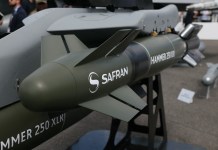With U.S. President Donald Trump signing the ‘Big Beautiful Bill’ into law on July 4, questions are being raised about one of its fallouts on the American military’s ‘clean energy mission,’ which was promoted with great intensity under the previous Biden Administration.
For President Biden, climate change was the “greatest threat” to US national security, and to assert his goal, he echoed the concerns of many national security and military leaders.
After all, for many years, the US Army, Navy, and Air Force have been working towards using more and more clean energy. In fact, the U.S. Army has been a leading advocate for achieving the goal of using only clean energy by 2035.
Incidentally, the military everywhere is increasingly adopting clean energy technologies to enhance operational capabilities, improve energy security, and reduce environmental impact.
This shift encompasses the utilization of renewable energy sources, including solar and wind power, microgrids, and hydrogen fuel cells. These technologies are being integrated into military bases, forward operating bases, and even entire military sites, leading to greater energy independence and reduced reliance on fossil fuels.
It is worth noting that the American armed forces and their respective establishments are among the largest institutional consumers of fossil-based or nonrenewable energy in the world. After all, energy is essential to every aspect of military operations, from fueling ships and aircraft to powering military bases.
However, President Trump does not seem to mind this reliance on traditional sources of energy. For him, America is blessed with an abundance of conventional energy and natural resources that have historically powered its economic prosperity.
According to him, “In recent years, burdensome and ideologically motivated regulations have impeded the development of these resources, limited the generation of reliable and affordable electricity, reduced job creation, and inflicted high energy costs upon our citizens. These high energy costs devastate American consumers by driving up the cost of transportation, heating, utilities, farming, and manufacturing while weakening our national security.
“It is thus in the national interest to unleash America’s affordable and reliable energy and natural resources. This will restore American prosperity —- including for those men and women who have been forgotten by our economy in recent years. It will also rebuild our Nation’s economic and military security, which will deliver peace through strength”.
And it so happened that on the very first day he took the oath for the second time as the U.S. President (January 20, 2025), he signed his first executive order to terminate all existing official programs promoting clean energy. Apparently, his first budget, which was approved by Congress a few days ago, takes this policy further.
Notwithstanding Trump’s philosophy, the increasing realization worldwide that the military should not exclusively depend on fossil fuels has reasons other than mitigating and adapting to the dangers of global warming through climate change.
For instance, if the military continues to rely only on fossil fuel, any disruption to global fossil fuel supplies will drive up costs and divert resources from other warfighting priorities. Experts have proved this by citing high energy prices in Europe and Asia following the Russian invasion of Ukraine — and again with the Houthi shipping attacks (and U.S. retaliation) on the Red Sea.
It has been reported that the Pentagon is now paying more for oil than it did in previous years. In 2019, the Defense Logistics Agency (the DOD agency responsible for fuel distribution for the U.S. military and civilian contractors) distributed approximately 94.2 million barrels of oil, valued at $12.1 billion. In 2023, the same agency distributed 79.5 million barrels, worth $13.3 billion.

Apparently, aviation accounts for an average of 85% of liquid fuel demand. It has been reported that during the Gulf War in 1991, the U.S. burned in a single day the equivalent of ten times Poland’s daily fuel use in 2025.
Incidentally, the above figures were arrived at before the advent of modern jets. These will be much higher now. For instance, an F-35 is reportedly required to use 60% more fuel than an F-16.
Even otherwise, the militaries are increasingly clamouring for more and more on “the reliable supply of energy”, as they need to use it more and more on new technologies, including energy-intensive weaponry such as anti-drone lasers and signal-jamming equipment. The military will need more energy in the coming days.
In this environment, solving energy dependencies has thus become a big challenge for operational capacity. This challenge, in turn, has two dimensions. They provide opportunities, too.
One is for military installations or establishments to become as self-reliant as possible regarding the power supply. This is achieved by building microgrids — localized systems capable of producing power independently of external sources. The idea is to be more autonomous and less reliant on civilian energy infrastructure.
It is worth noting that currently, military bases tend to connect to local grids with diesel generators for backup. However, such a system is highly vulnerable in the event of any disruption to the electricity supply, owing to an electricity shortage, local or regional outages, a blackout, or any natural disaster.
Secondly, as the wars in the former Yugoslavia, Iraq, and currently in Ukraine have shown, energy and electricity infrastructures are often primary strategic targets for bombings or missile attacks by adversaries. Therefore, it is all the more reason that the military has got its own source of supply as much as possible.
Against this background, renewable electricity supply is viewed as making the military more resilient. For instance, to reduce its dependence on fossil fuel consumption, the United Kingdom recently experimented with using 100% biofuels to power its Typhoon jets. Norway has also run similar tests on the F-16.
Earlier experiments involved blending biofuels with existing fossil-based fuels. Of course, it remains to be seen whether 100 percent biofuel will eventually be used, as under NATO’s single fuel policy, the same fuel should be applicable to all NATO aircraft. But, it is important that alternatives are being explored.
Similarly, Green hydrogen, as a clean energy source, is being explored for application in the military sector. From armored tanks to logistical trucks, the military requires substantial amounts of fuel to operate its ground forces effectively. And here, it is said that hydrogen fuel cells offer numerous advantages over conventional combustion engines, including faster refueling times, longer operational range, and greater fuel efficiency.
It is worth noting that the Indian Army has initiated a pilot project in Ladakh, bordering China, to utilize hydrogen as a power source for heavy transport vehicles. This project aims to make the armed forces less dependent on fossil fuels and protect the fragile ecology of the region. Moreover, hydrogen vehicles are quieter than traditional combustion engines, giving them a stealth advantage in tactical military operations.
Yet another development has been the emergence of small modular nuclear reactors (SMRs), which have been gaining traction globally as they provide reliable, steady flows of off-grid electricity to data centers and industrial hubs.
Reportedly, the US military has been testing mobile SMRs, with “Project Pele” developing reactors compact enough to be transported in shipping containers.
It may be noted that a Defense Science Board study in 2016 had predicted that “the U.S. military could become the beneficiaries of reliable, abundant, and continuous energy through the deployment of nuclear energy power systems” and urged the DOD to explore such options. In response, DOD initiated Operation Pele, named after the Hawaiian god of fire, and tasked it with a mission “to design, build, and demonstrate a prototype mobile nuclear reactor within five years.”
Eight years later, in September 2024, engineers at the Idaho National Laboratory (INL) broke ground on a transportable nuclear reactor. The prototype high-temperature gas-cooled mobile microreactor is designed to be transported in four 20-foot shipping containers.
Assembly was scheduled to begin in February 2025, and the final, fully assembled reactor was to be delivered to INL by 2026.
The Pentagon is also reported to be seeing solar energy as a potential pathway forward. The Joint Forces Training Base in Los Alamitos, California, has installed a hybrid solar microgrid to enhance its resilience against energy disruptions. It is said that the base would be self-sustaining for 14 days on this microgrid in the event of a civilian grid failure.
Viewed thus, the shift to clean energy provides the military with many strategic advantages. But President Trump does not seem to be convinced.
- Author and veteran journalist Prakash Nanda is Chairman of the Editorial Board of the EurAsian Times and has been commenting on politics, foreign policy, and strategic affairs for nearly three decades. He is a former National Fellow of the Indian Council for Historical Research and a recipient of the Seoul Peace Prize Scholarship.
- VIEWS PERSONAL OF THE AUTHOR
- CONTACT: prakash.nanda (at) hotmail.com




